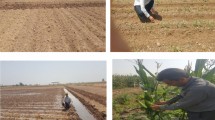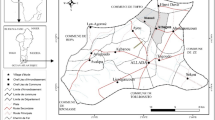Abstract
With respect to the significance of improving hybrid corn performance under stress, this experiment was conducted at the Islamic Azad University, Arak Branch, Iran. A complete randomized block design with three levels of irrigations (at 100%, 75% and 50% crop water requirement), two levels of arbuscular mycorrhizal (AM) fungi (Glumus intraradisis) (including control), and three levels of zinc (Zn) sulfate (0, 25 and 45 kg ha−1), was performed. Results of the 2-year experiments indicated that irrigation treatment significantly affected corn yield and its components at P = 1%. AM fungi and increasing Zn levels also resulted in similar effects on corn growth and production. Although AM fungi did not significantly affect corn growth at the non-stressed irrigation treatment, at moderate drought stress AM fungi significantly enhanced corn quality and yield relative to the control treatment. The combined effects of AM fungi and Zn sulfate at 45 kg ha−1 application significantly affected corn growth and production. In addition, the tripartite treatments significantly enhanced corn yield at P = 1%. Effects of Zn and AM fungi on plant growth under drought stress is affected by the stress level.
Similar content being viewed by others
References
Auge RM (2001) Water relations, drought and vesicular-arbuscular mycorrhiza symbiosis. Mycorrhiza 11:3–42
Auge RM, Stodola AJW, Tims JE (2001) Moisture retention properties of a mycorrhizal soil. Plant Soil 230:87–97
Baker DE, Amachar MC (1982) Nickel, copper, zinc and cadmium. In: Page AL, Miller RH, Keeney DR (eds) Methods of soil analysis, part 2. American Society of Agronomy, Madison, pp 323–338
Bray DE (1997) Plant responses to water deficit. Trends Plant Sci 2:48–54
Brown PH, Cacmak I, Zhang Q (1993) Form and function of zinc in plants. In: Robson AD (ed) Zinc in soil and plants. pp 93–1.6. Kluwar Academic Publishers
Cakmak I (2000) Possible roles of Zinc in protecting plant cells from damage by reactive oxygen species. New Phytol 2:85–205
Cheong YH, Kim KN, Pandey GK, Gupta R, Grant JJ, Luan S (2003) CLB1, a calcium sensor that differentially regulates salt, drought, and cold responses in Arabidopsis. Plant Cell 15:1833–1845
Daei G, Ardakani MR, Rejali F, Teimuri S, Miransari M (2009) Alleviation of salinity stress on wheat yield, yield components, and nutrient uptake using arbuscular mycorrhizal fungi under field conditions. J Plant Physiol 166:617–625
Elwan LM (2001) Effect of soil water regimes and inoculation with mycorrhizae on growth and nutrients content of maize plants. J Agric Research 28:163–172
Feldman F, Idczak E (1992) Inoculum production of vesicular-arbuscular mycorrhizal fungi for use in tropical nurseries. In: Norris JR, Read DJ, Varma AK (eds) Methods in microbiology, techniques for the study of mycorrhiza. Academic, New York
Gee GW, Bauder JW (1986) Particle-size analysis. In: Klute A (ed) Methods of soil Analysis, Part 1. 2nd ed., Agronomy Monographs, vol. 9. ASA and SSSA, Madison, pp 383–411
Ghazi AK, Zak BM (2003) Field response of wheat to arbuscular mycorrhizal fungi and drought stress. Mycorrhiza 14:263–269
Giovannetti M, Mosse B (1980) Estimating the percentage of root length colonized (Gridline-Intersect Method). New Phytol 84:489–500
Hopkins WG, Huner NP (2004) Introduction to plant physiology (3rd ed). John Wiely & Sons. Inc, New york, 560 p
Knudsen D, Peterson GA, Pratt PF (1982) Lithim, sodium and potassium. In: Page AL et al (ed) Methods of soil analysis: part 2. Chemical and microbiological properties. ASA monograph number 9. p 225–246
Laffitte HR, Edmeades GO (1995) Stress tolerance in tropical maize is linked to constitutive change in ear growth characteristics. Crop Science 3:820–826
Lam F (2004) Corn production as related to sprinkler irrigation acpacity.16th annual central plains irrigation conference, Kearney, Nebraska, Feb 17–18
Liu R, Li M, Meng X (2000) Effects of AM fungi on endogenous hormones in corn and cotton plants. Mycosystem 19:91–96
Mahaveer PS, Singh R, Adholeya A (2000) Laboratory manual for basic techniques in arbuscular mycorrhizal research. Center for Mycorrhizal Research, Tata Energy Research Institute, New Delhi
Marschner H (1993) Nutrient dynamics at the soil–root interface (Rhizosphere). In: Read DJ, Lewis DH, Fitter AH, Alexander IJ (eds) Mycorrhizae in ecosystems. CAB International Publisher
Marschner H, Dell B (1994) Nutrient uptake in mycorrhizal symbiosis. Plant Soil 159:89–102
Miransari M, Bahrami HA, Rejali F, Malakuti MJ, Torabi H (2007) Using arbuscular mycorrhiza to reduce the stressful effects of soil compaction on corn (Zea mays L.) growth. Soil Biol Biochem 39:2014–2026
Miransari M, Bahrami HA, Rejali F, Malakuti MJ (2008) Using arbuscular mycorrhiza to reduce the stressful effects of soil compaction on wheat (Triticum aestivum L.) growth. Soil Biol Biochem 40:1197–1206
Miransari M, Rejali F, Bahrami HA, Malakouti MJ (2009a) Effects of soil compaction and arbuscular mycorrhiza on corn (Zea mays L.) nutrient uptake. Soil Tillage Res 103:282–290
Miransari M, Rejali F, Bahrami HA, Malakouti MJ (2009b) Effects of arbuscular mycorrhiza, soil sterilization, and soil compaction on wheat (Triticum aestivum L.) nutrients uptake. Soil Tillage Res 104:48–55
Miransari M (2010) Contribution of arbuscular mycorrhizal symbiosis to plant growth under different types of soil stresses. Review article. Plant Biol 12:563–569
Moussa HR, Abdel Aziz M (2008) Comparative response of drought tolerant and drought sensitive maize genotypes to water stress. Aust J Crop Sci 1:31–36
Munns R (2002) Comparative physiology of salt and water stress. Plant Cell Environ 25:239–250
Nelson DW, Sommers LE (1973) Determination of total nitrogen in plant material. Agron J 65:109–112
Nelson DW, Sommers LE (1982) Total carbon, organic carbon, and organic matter. In: Page AL, Miller RH, Keeney DR (eds) Methods of soil analysis, part 2, 2nd edn. American Society of Agronomy, Madison, pp 539–573
Olsen RS (1954) Estimation of available phosphorus in soils by extraction with sodium bicarbonate. US Department of Agriculture. No. 939
Ramazanzadeh H, Avestan SH, Reihanitabar A (2007) Effect of some factors on zinc absorption in soil calcareous. In 10th Soil Science Congress. Karaj. Iran
Read DJ, Koucheki HK, Hodgson J (1976) Vesicular-arbuscular mycorrhiza in natural vegetation systems. New Phytol 77:641–653
Rhoades DJ (1982) Soluble salts. In: Page AL, Miller RH, Keeney DR (eds) Methods of soil analysis, Part 2, 2nd edn. American Society of Agronomy, Madison, pp 167–178
Sas Institute Inc. (1988) SAS/STAT user’s guide. Version 6. Fourth edition. Statistical Analysis Institiute Inc., Cary North Carolina. 1988
Song H (2005) Effects of VAM on host plant in condition of drought stress and its mechanisms. Electron J Biology 3:44–48
Steel RGD, Torrie JH (1980) Principles and procedures of statistics: a biometrical approach, second edition. McGraw-Hill Book Company
Vahedi M (1988) Corn plantation, growth and harvest. In Persian, published by the Bureau of Tarvij Keshavarzi
Wang H, Jin JY (2007) Effects of zinc deficiency and drought on plant growth and metabolism of reactive oxygen species in maize (Zea mays L). Agric Sci China 6:988–995
Wang H, Liu RL, Jin JY (2009) Effects of zinc and soil moisture on photosynthetic rate and chlorophyll fluorescence parameters of maize. Biol Plant 53:191–194
Xiong L, Schumaker K, Zhu JK (2002) Cell signaling during cold, drought, and salt stress. Plant Cell 14:165–183
Yilmaz A, Ekiz H, Torun B, Gultekin I, Karanlik S, Bagei SA, Cakmak I (1997) Effect of different zinc application methods on grain and zinc concentration in wheat cultivares grown on zinc deficient calcareous soils. J Plant Nutr 20:461–471
Author information
Authors and Affiliations
Corresponding author
Rights and permissions
About this article
Cite this article
Sajedi, N.A., Ardakani, M.R., Rejali, F. et al. Yield and yield components of hybrid corn (Zea mays L.) as affected by mycorrhizal symbiosis and zinc sulfate under drought stress. Physiol Mol Biol Plants 16, 343–351 (2010). https://doi.org/10.1007/s12298-010-0035-5
Published:
Issue Date:
DOI: https://doi.org/10.1007/s12298-010-0035-5




